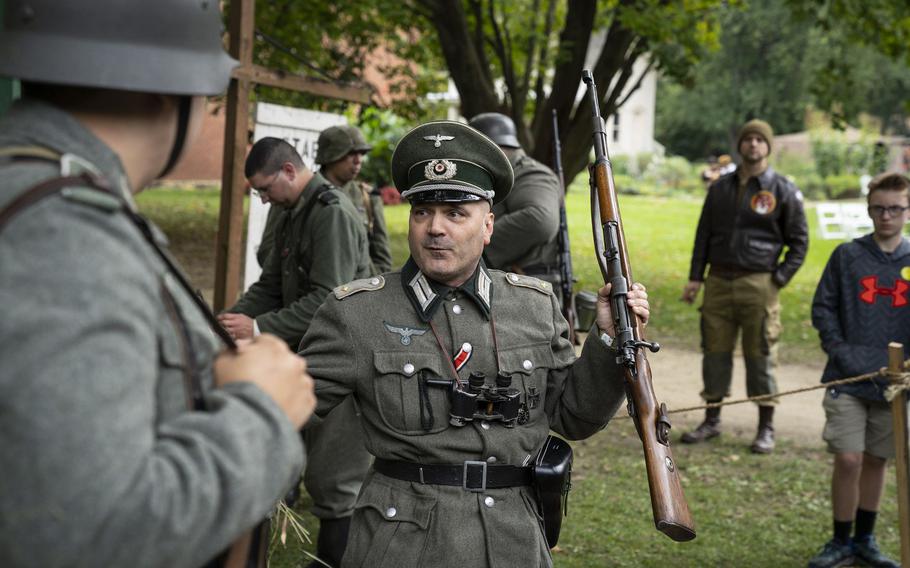
World War II reenactor Dave Fornell of Elgin at the Rockford World War II Days event at Midway Village Museum on Sept. 24, 2022, in Rockford, Ill. (E. Jason Wambsgans, Chicago Tribune/TNS)
ROCKFORD, Ill. (Tribune News Service) — Someone has to play the bad guy.
Someone has to play the Nazi.
Otherwise, how do you teach history?
I heard this a lot. Whenever I would ask anyone portraying a German soldier at Rockford’s annual World War II Days about why they had chosen to reenact a soldier on the Axis side of the war, eventually, almost to the person, after offering many different reasons, they would adopt a sheepish grin and say:
Because someone has to.
Besides, they would usually add, they were not playing the bad Germans. They were playing schmucks, the lowest of the low, conscripted men who feared what would happen to their families if Hitler won and they had avoided service. Most said this. They were here as actors. They were playing a part.
“It’s a costume, man,” one guy in an SS uniform told me. They were also here as educators, as amateur historians. They also played Nazis because they thought the costumes were cooler, the equipment and vehicles more interesting — many compared it to being a child and how it’s always more fun to play Darth Vader than a humble Jedi.
Some mentioned they had family who fought in the German army (though many more said they had family who fought for the Allies). Some chose the German side to better understand the German side. Many said they wanted to use reenacting to ensure “nothing like this” takes place again.
Then they would add they are red-blooded Americans, with no sympathy for Nazis or fascist ideology. In fact, they didn’t want to talk politics. It gets too heated, they would say, a surreal point coming from someone in a Nazi uniform. Again, they were playing German. Ask about their “role in the war” and prepare to be there a while. They were sincere, thoughtful and knowledgeable.
But the swastikas on those costumes get distracting.
You start to notice how simultaneously deep and shallow their understanding can go.
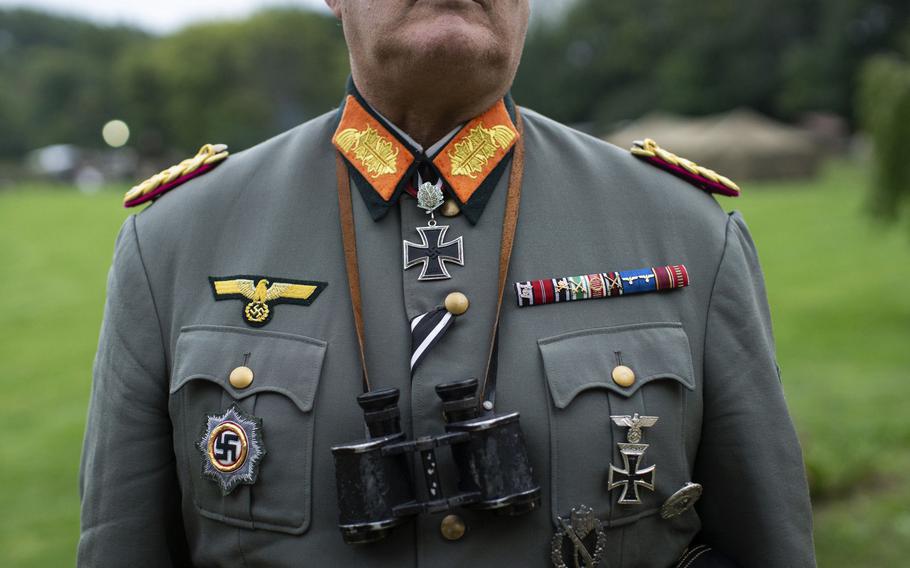
Ted O’Sullivan portrays a German WWII officer at the Rockford World War II Days event on Sept. 24, 2022, in Rockford, Illinois. (E. Jason Wambsgans, Chicago Tribune/TNS)
I’ve been attending World War II Days in Rockford for about six years now, on and off, as a spectator. It’s the second-largest World War II reenactment in the country. For 26 years, in early autumn, it’s attracted about 1,000 reenactors, give or take a few hundred. It runs for three days — one for student groups, two for the public — on the 148-acre campus of Rockford’s Midway Village Museum, among faux-historic buildings. About a third of registered reenactors play on the side of Axis powers.
Whenever I would tell friends I attended, they would respond that they only knew of Civil War reenactments, and then, after a beat, a shock would kick in and they would ask:
Wait, so they have Nazis? Who would play a Nazi?
This was such a good question I returned to World War II Days earlier this fall to ask German reenactors why — particularly in an age of Proud Boys, resurgent white nationalism and fascism-friendly populists — are you still playing a Nazi?
Or more important, how?
The answer, of course, is complicated. And often, not altogether satisfying. In short: They look the part. They take fidelity to their roles very seriously, obsessively so. Dave Fornell of Elgin, scarily convincing in a green wool German lieutenant uniform and cap, adorned with the swastikas and eagles and insignia of the Nazi military, sat on the porch of the Axis-occupied headquarters and surveyed the fields in front of him. Though it wasn’t intended, his 5 o’clock shadow and dark eyes suggested tired days of battle.
“The idea is we’re in a French village, and we have taken it over and this is German division headquarters,” he said, pointing out the extent of the occupation. The field hospital over there, the guy who pays salaries over there, the guy who tends to horses (played by real horses), the cobbler who actually repairs the boots of Axis reenactors.
Most of the reenactment sprawled across the land behind the museum, mingled in among the faux-historic structures. On one end was an Allied camp with soldiers; on the other, this Axis occupation. But people do need to eat and the Axis side had taco and barbecue vendors, so period Jeeps full of American soldiers rolled slowly past the enemy and stopped for plates of Al pastor. It’s a clash of images. A child in a Nazi uniform clearly too big for him suggested the desperation of a losing side. A man playing a Nazi officer with a German shepherd — its mouth clamped tight behind a metal muzzle — walks by two women cosplaying as Andrews Sisters. German paramedics shoot the breeze with Allied war correspondents.
Fornell, for years, has been a lead organizer of World War II Days, and was briefly president of the World War II Historical Reenactment Society, which has 1,200 members, primarily in the Midwest. Like many WWII reenactors, sometimes he plays an Allied soldier, though usually he plays a German lieutenant. He prefers to play a German. Reenactors call this an “impression,” and usually they have clothing and gear for several different impressions.
“There is a lot of baggage in doing a German impression,” he said. “My elevator pitch on why I do German has to do with their surrender in World War I, hyperinflation in Germany, the polarization of far right and far left. A lot of people bought into the idea to make Germany great again. A lot of people who do Germans at events want to wrap their heads around that German psyche, why they fought for Hitler, how atrocities could have taken place. At the end of the day, we deliver a story, say what happened, who these people were.”
On the grass in front of the headquarters were dozens of weapons from WWII, many owned by Fornell. A man in a German soldier uniform explained them to spectators.
A man in a bear costume fell into a chair beside Fornell. He was playing the Fanta bear, the mascot of the soda company created in Germany after Coca-Cola pulled out of the country. The man tugged the head off. Sweat ran down his face. Authenticity extended here, too. The bear was ratty, and the teeth were real, courtesy of a taxidermied grizzly.
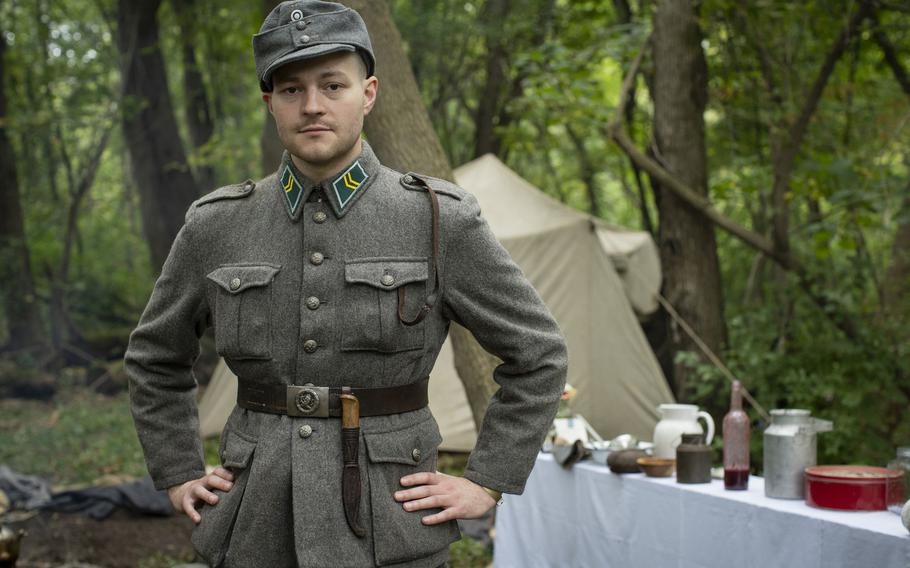
Christian Lachtara portrays a Finnish soldier at the Rockford World War II Days event at Midway Village Museum on Sept. 24, 2022, in Rockford, Ill. (E. Jason Wambsgans, Chicago Tribune/TNS)
In the wooded trails beyond the village, smoke from campfires curled through trees. Scattered among foxholes and tents were German and American troops, but also reenactors playing Austrian, Cossack, Italian, Ukrainian. Some take part in large, loud battles in a nearby field, but not unlike in real war, many wait around their camps, which resemble living historic dioramas. They eat only food these soldiers would eat. Some model their posture on archival photos, occasionally sneaking a peek at their cellphones.
Ask an Axis soldier in these woods why they chose an Axis power, they share fairly lockstep answers: Really, they’re playing a common soldier, apolitical cannon fodder, a guy who probably knew nothing about atrocities, never mind took part in death camps. They themselves, in real life, are security guards and bank workers and tech workers and delivery guys and stay-at-home dads and journalists and engineers and veterans. Some say the appeal was researching the specific real-life unit they are portraying. One guy said he was a (real) U.S. Marine and didn’t “want to put on an Army uniform.”
But generally, as a soldier in an Austrian mountain division (who didn’t want his name used) explained: “You’re just a dude living in a hole, hating life. The shared experience of war.”
Some do get confronted by spectators who mistake them as Nazi sympathizers. Dan, who would only identify himself as an O’Hare International Airport employee, said: “Yeah, we get people who assume we think like (Nazis), but really there’s zero tolerance in these circles for anything like that.”
And yet, those uniforms, those swastikas — it’s startling.
“At the end of the day, to do war reenactments, maybe people should feel discomfort,” said Christian Lachtara of Kankakee, playing a Finnish soldier. “Feels appropriate, yes?”
Actually, yes, said Goldie Pekarsky, executive director of the Jewish Federation of Greater Rockford, which has presented lectures here on the Holocaust for several World War II Days. She thinks of the event “as kind of like a big play.”
That said, when she attends she never leaves the physical museum building or visits reenactments. Her parents were Holocaust survivors; she herself was born in a refugee camp in Germany. “Though I think maybe people should feel uncomfortable,” she said. “Maybe that’s only wise.” Driving a cart around the grounds during World War II Days, Laura Furman, the museum’s curator of collections and education, said they need to be able to educate people on all sides of history, while being sensitive. “Unfortunately, it feels relevant now.”
Still, Allison Hayden, dressed in a floral print dress and thick midcentury eyeglasses, wondered how much of an understanding of World War II these people actually share.
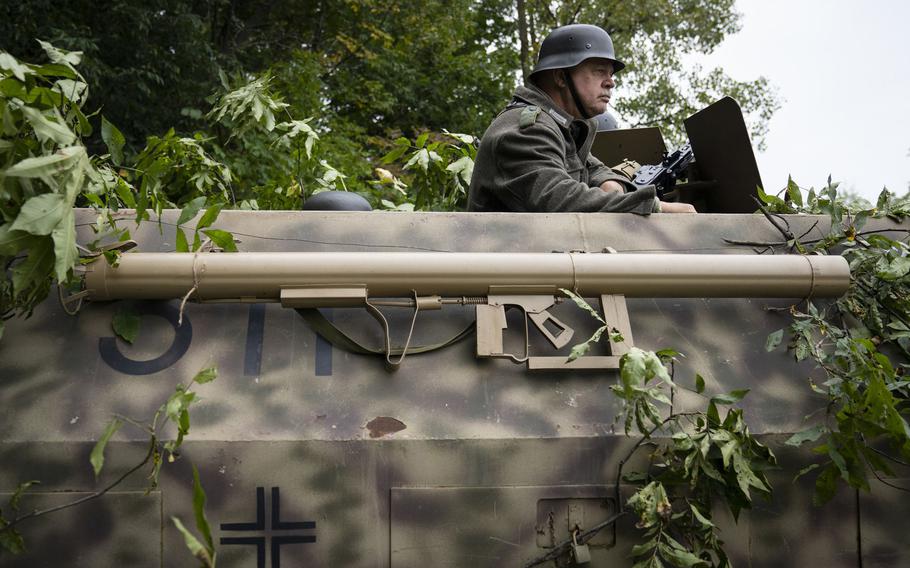
Reenactors portraying Germans during a battle at the Rockford World War II Days event on Sept. 24, 2022, in Rockford, Ill. (E. Jason Wambsgans, Chicago Tribune/TNS)
The theme of this year’s World War II Days was the Holocaust. This played out primarily through a series of talks in the museum and via two information areas on the reenactment grounds. One, organized by a small group of Wisconsin women, tackled the Warsaw Ghetto. Across the path from them, just inside the doors of the village’s faux bank, was Hayden, behind a table of books about the Jewish resistance, answering questions on the Holocaust for anyone who stopped. A spectator told her it was hard to imagine how a massive genocide happens.
Hayden explained as thoroughly as anyone might approach a subject so large.
The spectator asked if there was “a basis” for antisemitism.
Hayden, who tracks acts of antisemitism in Wisconsin for the Milwaukee Jewish Federation, gulped. You never knew what someone is implying with some of these questions. Hayden politely reached back hundreds of years, succinctly as possible. She’s been coming to World War II Days for years. She’s also a reenactor, mostly in a Yugoslavian infantry division. But one of the things that always bothered her about World War II reenactments was how comfortably they sidestepped moral questions. So she asked the organizers if she could have an information booth on the Holocaust.
It’s been interesting, she said.
The day before a reenactor playing a German soldier told her a gas chamber joke; his commanding officer made him apologize. For a while, at other reenactments, the same German reenactor would greet her with a jokey shout of “Sieg Heil!” But in general, she said, other than one or two German units, “the worst part is most of these guys don’t want to acknowledge what Germans did. They find it depressing or don’t know enough to speak knowledgeably. If you’re playing German, you need to know more about their role in the war than what their uniforms looked like. I understand wanting to go deep on the material culture of all this and the guns and tanks, but if you just do that you’re missing the social context and why you are here in the first place.”
You’re purporting to teach history while ignoring the ugliest elephant in the room.
Hayden added: “It’s not like I’m expecting everyone here to be a Holocaust historian, and of course families at events like this are not anxious to discuss genocide. But for reenactors to always be playing a so-called innocent soldier is avoiding stuff on purpose. You hear things like only the SS participated in killing the Jews, and that’s just wrong.”
Peggy Wright, who was taking questions nearby about female spies and the Warsaw Ghetto, said she was surprised that WWII reenactors get asked to intentionally avoid mentions of politics or ideology.
“I mean, isn’t this whole thing political?”
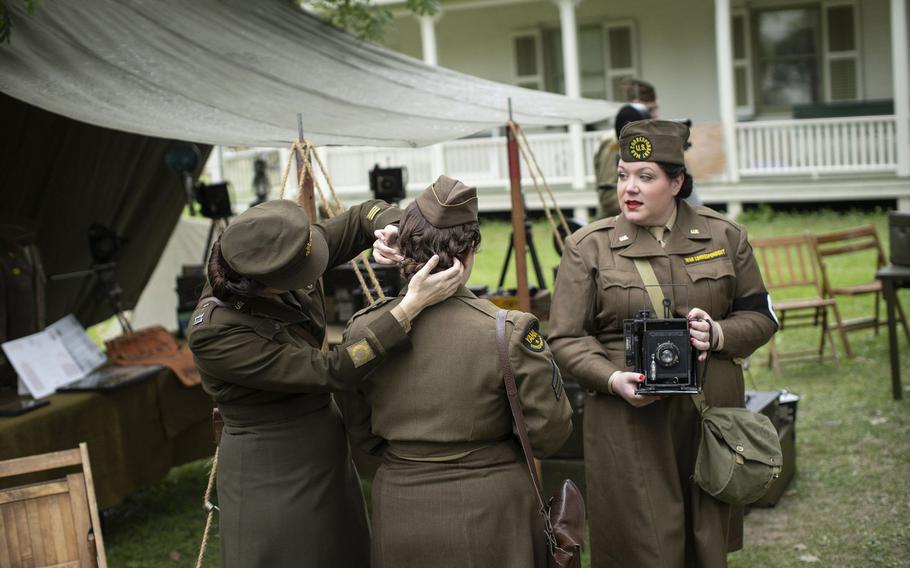
War correspondent reenactors at the Rockford World War II Days event, in Rockford, Ill. (E. Jason Wambsgans, Chicago Tribune/TNS)
The war reenactment, as a sort of edu-tainment form, goes back millenniums. Romans staged reenactments of key battles. Closer to this century, veterans of the Civil War restaged pivotal skirmishes during reunions with their fellow soldiers. Living history, as it’s sometimes called, removed from the darker causes of a conflict and streamlined back into a series of action sequences and artifact exhibitions, is not new.
World War II reenactments started in the mid-1970s and have spread worldwide — though in Germany, portraying Nazi soldiers is not allowed. In this country, there are roughly 10,000 or so reenactors who take part annually in WWII reenactments, which is about three times fewer than the number of Civil War reenactors.
Paul Durica, director of exhibitions for the Chicago History Museum, himself an acclaimed reenactor of (typically 19th-century) local history, said Civil War reenactors often face similar issues as World War II reenactors. Namely, Civil War reenactments tend to shy from acknowledging that a battle is being fought over the right to enslave another human. It hasn’t helped the hobby. A few years ago, an annual Civil War reenactment in Wauconda was briefly canceled when president of the Lake County Forest Preserves District (which hosts the event) objected to using Confederate flags, among other reasons.
Durica said, “Reenactments have a duty to reflect history accurately to an extent it’s possible but also to put stories in context. As someone fascinated by this form, I’m always looking at where it falls short, and consistently you see them losing sight of larger context and meaning behind an act of memory. With the Civil War, for instance, there’s emphasis on clothes, military maneuvers. I don’t know the solution here, but there’s a problem when you separate a battle from reasons it’s being fought.”
Luke Fredrickson, director of marketing at Midway Village, said: “It’s not the role of the reenactor in a soldier’s uniform to educate viewers on an ideology. This is a battlefield environment, and you’re presuming that the average German soldier was political.”
But Charles Bolanis III, the Indianapolis-based president of the World War II Historical Reenactment Society — which describes itself as focused on military activity — said a number of younger reenactors in the hobby have been “wanting to have the conversation,” wondering how to weave the Holocaust and moral depravity of Nazism into the hobby.
Living in America in 2022, he said, it’s just harder now to avoid some of this stuff. “So of course, it’s gotten difficult to play German,” he said. “Not unbearable, just difficult. I have had to emphasize to German reenactors they bear more responsibility now. There’s no room for even appearing to be a Nazi apologist. If they want to do this they need to bear in mind they are portraying one of the most hated regimes in history. But I understand some units have a policy to avoid those discussions for fear it will be taken out of context. There is this underlying fear of the media. And some of these guys, they might be smart historians, but they don’t always have the best public-relations skills.”
Absurd as it sounds, there isn’t much diversity in Nazi reenacting.
Or really, in war reenactment in general. Like many hobbies, it’s pretty insular. Finding reenactors to play Japanese soldiers is rough. Likewise, though Vietnam War events are becoming more popular among reenactors, Vietnamese soldiers are rarely represented. Mostly, it’s all white men.
Things started to change because of Rich Iott, Bolanis said, referring to the scandal that erupted in 2010 when Iott, a Republican candidate in Ohio for U.S. Congress, was shown by the Atlantic magazine to be portraying a member of the SS for a WWII reenactment. Iott, whose candidacy soon collapsed, offered familiar reasons: He was merely playing a slice of history; someone has to play a bad guy. Bolanis, who also plays German, was a member of Iott’s unit. Bolanis even made recruitment videos, later shown and mocked on “The Daily Show.” Bolanis said the group had rarely been questioned about the politics of their hobby, so when Iott made headlines, German reenactors “never saw it coming.”
Irresponsible. That’s how Kelley Szany, vice president of education and exhibitions at the Illinois Holocaust Museum & Education Center in Skokie, characterizes the handling of German reenactments: “It’s stunning, reenacting this on our own soil, never mind not fully understanding their role itself. Nazism infiltrated all levels of the (German) military. It’s a massive misconception that the so-called ordinary men were not complicit or had any connection to crimes. It does a disservice to avoid that. Ultimately whether we like it or not, the Holocaust was committed by ordinary men and soldiers. Just because you don’t wear this or that patch doesn’t mean the uniform itself doesn’t represent ideology.”
I told her that what often draws people to reenacting Nazis is the aesthetics.
She laughed. “Yeah, fascist aesthetics. This was an ideology through and through.”
Hayden said that a kind of moral relativism among German reenactors, a reflexive butwhataboutism, has hurt a hobby that’s full of thoughtful people, seriously interested in acting as stewards of history. Whenever she’s pushed a WWII reenactment to include a modicum of Holocaust history, she hears inevitably from outraged German reenactors that if they include the Holocaust then Stalin’s genocide in the Soviet Union needs to be included too. Indeed, when I asked Tom Novosel, a retired steelworker from Indiana playing a commanding officer, why he chose a German impression, he said: “Because Germans got screwed at the Treaty of Versailles. I agree Jewish people were scapegoated. But who isn’t? Right now we have President Biden making scapegoats of Trump voters!”
A German reenactor at World War II Days is not without restrictions. Again, organizers ask them not to wear anything anything political, or perform a political act — though what this means is, at best, unclear. Because the Holocaust was the theme this year, the museum discussed whether it should allow reenactors to portray Jewish prisoners wearing yellow stars. But ultimately — no. Also, goose-stepping is considered political. Reenacting the role of Hitler is definitely not allowed. Wearing black Nazi armbands is political. Swastika flags are political. But incorporating Nazi symbols into uniforms is fine. “There is no way to have historically accurate uniforms without that,” Furman said. “History can’t be one-sided.”
White nationalism is a fear among German reenactors. Because the hobby attracts vintage gun collectors and anyone willing to slide into Nazi boots for a weekend, it’s not an unfounded fear. Fornell said the FBI once infiltrated a unit of German reenactors on the assumption they were a militia. “We are worried, yes, because we’ve had problems,” he said. “Not many, but it happens. We’ve had to toss people who are too far, far right-wing, so to speak. They show sympathy to Nazis, it’s a red flag.”
Likewise, German reenactor units say if they spot any white nationalist slogans or symbols tattooed on a member, they’re gone. But again, it happens. Rick Pennington, a Quad Cities social studies teacher and member of a unit reenacting the German 716th infantry division, said they feel new members out. “’Is this person here for the right reasons?’ You have to ask. Still ...” — he looked around at World War II Days’ elaborate German tableaus — “a reenactment this large, you got to assume there is some white nationalist sympathy.”
Bolanis urges new WWII reenactors to explain their hobby to employers; everyone here has heard stories of reenactment photos getting back to an unsettled HR department. He also suggests that members get some work as TV or film extras, a fairly common gig for many reenactors. That and an IMDb page could help remind friends or colleagues that it’s acting.
Plus, like many hobbies, it’s expensive, an investment.
The cost of playing army — assembling authentic gear, recreated clothes with the correct thread-count and wools, etc. — is about $1,000 on the low end, but roughly 10 times that for many of these guys. And that’s before they start buying vintage vehicles.
The result is that walking around World War II Days is an immersive mash of history and commitment. Kids playing Hitler Youth wrestle in the grass a stone’s throw from a faux-USO office. German motorcycles rumble past vendors selling watercolor prints by Hitler. The pop-pop of rifle blanks reach in from surrounding fields; women stroll by in period hairdos, their costumes smelling faintly of estate-sale mothballs; German officers step lightly around puddles. A Finnish unit looks composed of war-movie character actors. A U.S. soldier sits in a folding chair and a dummy grenade tumbles from his coat. A pair of Germans plan an ambush. “Wait, no, hold on,” one says, “I forgot, there’s no shooting in the village.”
Authentic as this all looks, as much as it claims to teach history, it feels weightless.
Fornell told me if no one is playing Confederates or Germans, history is lost; he likened playing German to being assigned to make an argument in debate club that you disagree with. But ironically, perhaps, they don’t go far enough. Walking around and discussing World War II with German reenactors is to get a sense that are recreating a nonexistent war in which everyone involved can claim a degree of innocence. No one says it outright, but many come close to saying there were very fine people on both sides.
As Durica said, “A lot of reenactors study primary historical materials, do due diligence and see this as public service — but they can also seem disconnected from the larger context.” Szany wondered, “Is there a way to do this that’s acceptable? That would mean having difficult conversations with everyone involved.”
Before I left World War II Days, I stopped at the command center for German officers. And they looked impressive, believable, very scary. They carried themselves with the proper smugness.
Ted O’Sullivan, a retired bank employee from Arizona, leaned back against a bench. A Panzer driver stood nearby, chatting with a U-boat commander. O’Sullivan said he rarely gets asked about the politics or responsibility that comes with playing a Nazi officer. He does it, partly, because he has a little German blood. That said, he also has a brother who doesn’t think he should do this.
He sighed and laced together his fingers.
He only plays a Nazi from spring until the early fall, he said. The rest of the year, he’s Darth Vader.
©2022 Chicago Tribune.
Visit at chicagotribune.com.
Distributed by Tribune Content Agency, LLC.